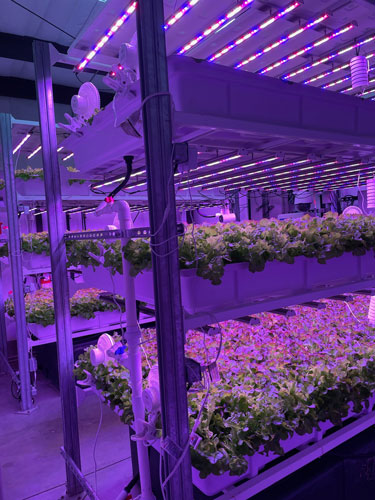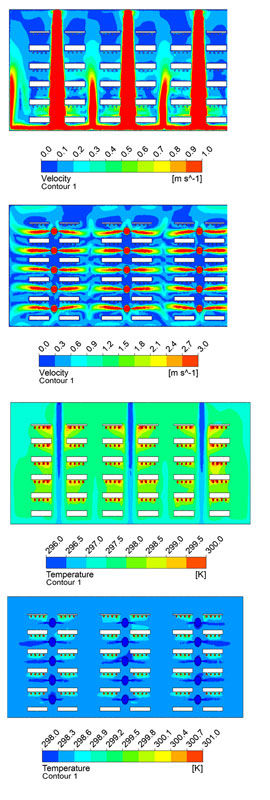8/1/2022
More Questions Answered
Erik Runkle, Murat Kacira & Cary Mitchell

Indoor farming, which refers to the production of high-value crops within repurposed or purpose-built buildings or containers using sole-source lighting, continues to expand in the U.S. and beyond. In the first article of this series, we introduced our OptimIA (optimizing indoor agriculture) project and addressed frequently asked questions (FAQs). Here, we address additional questions relating to the production of leafy greens within vertical farms with controlled environments. More information about our project is available at scri-optimia.org.
Q: What criteria should I use to select sole-source lighting?
A: This is a complex question not only from the technical plant-lighting side, but also from the economic side for commercial growers. Characteristics of electric lighting will depend on the desired responses (e.g., yield, foliar pigmentation, morphology, flavor or flowering) of the crop. Crops such as lettuce and microgreens can thrive under a relatively low light intensity (or low daily light integral), so they’re good candidates for indoor production (Figure 1).
Figure 1. Lettuce grown inside the vertical farming facility at the University of Arizona.
However, the efficacy of sole-source lighting is especially important for high-light-requiring fruiting and vining crops such as tomato. Today, most crops grown indoors under sole-source lighting are limited to high-value, relatively low-light-tolerant transplants, microgreens, leafy greens and culinary herbs with short production cycles, so that production space can be turned over frequently.
Spectral composition of the light source is also important, and responses vary widely from crop to crop and potentially from one market to another. Mixtures of white and red LEDs have become popular for commercial production of leafy greens. However, when it’s desirable to bring out leaf-pigmentation characteristics, such as anthocyanins (red and purple pigments) and other phytonutrient antioxidants in red-leaf lettuce or purple basil, elevated blue light may be needed.
The more sophisticated sole-source-lighting capabilities are, the higher the up-front capital costs will be, so growers need to carefully consider whether desired plant responses and economics will justify the costs of their sole-source-lighting technology investment. Such considerations will also drive crop choice, scope of the business operation and desired crop attributes.
Q: Does the increased cost of customizable lighting (ability to adjust intensity and wavelengths) justify the benefit of having the flexibility they allow?
A: This depends on how a wavelength-tunable lighting system will contribute to yield and crop quality attributes, as well as the cost and electrical efficiency of the lighting fixtures and control software. With customizable LED lighting, various light recipes can be tailored and controlled dynamically during crop growth stages to enhance color, phytonutrients, yield, morphology (development) and other quality attributes. Alternatively, different fixed spectrum fixtures or light intensities in different locations of a vertical farm could allow different lighting conditions during growth cycles to achieve a targeted crop yield and quality attribute outcome.
 Figure 2. Computational fluid dynamics (CFD) simulation evaluating climate uniformity based on air temperature and velocity distributions between two air distribution system alternatives.
Figure 2. Computational fluid dynamics (CFD) simulation evaluating climate uniformity based on air temperature and velocity distributions between two air distribution system alternatives.
Visit www.scri-optimia.org/pdf/KaciraResearchUpdate_2021.pdf for more information.
Source: University of Arizona-CEAC.
Q: How many hours a day should you run sole-source lighting?
A: The length of lighting depends on the crop grown, and whether its flowering is influenced by the lengths of day and night (photoperiod). For most crops that aren’t influenced by photoperiod, lighting can operate up to 20 to 24 hours per day. However, the number of hours of lighting may need to be decreased for several reasons, including the desire to induce or inhibit flowering, or to avoid peak electricity charges. For leafy greens such as lettuce, lighting at a lower intensity for a longer period of time each day can increase growth more than lighting at a higher intensity for a shorter period of time. (See scri-optimia.org/pdf/Mar21.pdf for details on this specific topic.)
Q: Do the light-emitting diodes (LEDs) used in indoor farms pose any health risks to workers?
A: Traditional LEDs are generally considered safe, however, certain high-energy wavelengths used for crop production can pose harm to humans. For instance, if UV light is used for any part of the production cycle to enhance crop quality attributes and/or manage crop disease or abnormalities, then direct exposure of workers to UV light should be avoided. Excessive eye exposure to high light intensities, especially blue light, can damage eyes, and thus the use of protective shields or light-filtering glasses is recommended. Some individuals become nauseous if they work under sole-source lighting that provides only red and blue light. Therefore, the addition of green light (usually from white LEDs) or use of filtering glasses can improve human vision and comfort.
Q: Is carbon dioxide injection necessary for indoor production?
A: Carbon dioxide (CO2) injection is particularly necessary when the plant growing area doesn’t have enough ventilation to introduce fresh air from the outside. Otherwise, CO2 concentration will decrease to a very low level that limits plant photosynthesis and thus growth, even when light and temperature are optimized. Therefore, the first objective is to ensure the CO2 concentration in the growing area is at least at ambient levels (410 to 420 ppm). An even higher CO2 concentration than outdoors typically increases photosynthesis, and therefore yield, especially under moderate to high light intensities. Consequently, commercial indoor vertical farm and greenhouse growers of vegetable crops often enrich the atmosphere to 800 to 1,200 ppm of CO2. In many commercial situations, especially for larger farms, the increase in harvestable yield is worth the cost of CO2 injection.
Q: What factors must be co-optimized in indoor farms?
A: Various factors must be co-optimized to help reduce costs,increase product value and quality attributes, and lead toward enhanced resource-use efficiency. Resource-use efficiency can be defined as the ratio of the produce yield or produce quality aspects as outputs to resources consumed as inputs (e.g., electrical energy, water, nutrients, CO2 and labor). Environmental factors to consider for co-optimization include air temperature, vapor-pressure deficit, daily light integral considering light intensity and photoperiod, light quality (spectrum), CO2 concentration and air flow and distribution (Figure 2). Root-zone factors to consider include electrical conductivity (EC), pH, dissolved oxygen, and nutrient composition and temperature.
Q: Do indoor farms and hydroponic systems need to be sterile?
A: Hydroponic production systems have a reputation for being sterile (i.e., without micro-organisms). Such is not the case, but it’s important that plant pathogens (such as Pythium root-rot) and other disease-causing bacteria, viruses, nematodes, fungi and insects be excluded from soilless systems in indoor agriculture, so appropriate sanitation must be practiced for well-managed hydroponics. Actually, a rootzone microbiome in hydroponic systems is desirable for disease suppression. For organic hydroponic and aquaponic crops, rhizosphere microbials are very important, not only for preventing pathogen infestation, but also to promote mineralization of nutrients for plant uptake from organic substrates. In fact, inoculation of hydroponic systems with beneficial microbes is on the rise. There’s considerable misunderstanding and confusion about running a “sterile” indoor farming operation, which is undesirable, and a “clean” operation, which is desirable. IG
Erik Runkle is a Professor and Extension Specialist in the Department of Horticulture at Michigan State University. Murat Kacira is a Professor in Biosystems Engineering Department at the University of Arizona. Cary Mitchell is a Professor in the Department of Horticulture and Landscape Architecture at Purdue University.
This project is supported by USDA-NIFA Specialty Crop Research Initiative (SCRI) award no. 2019-51181-30017.